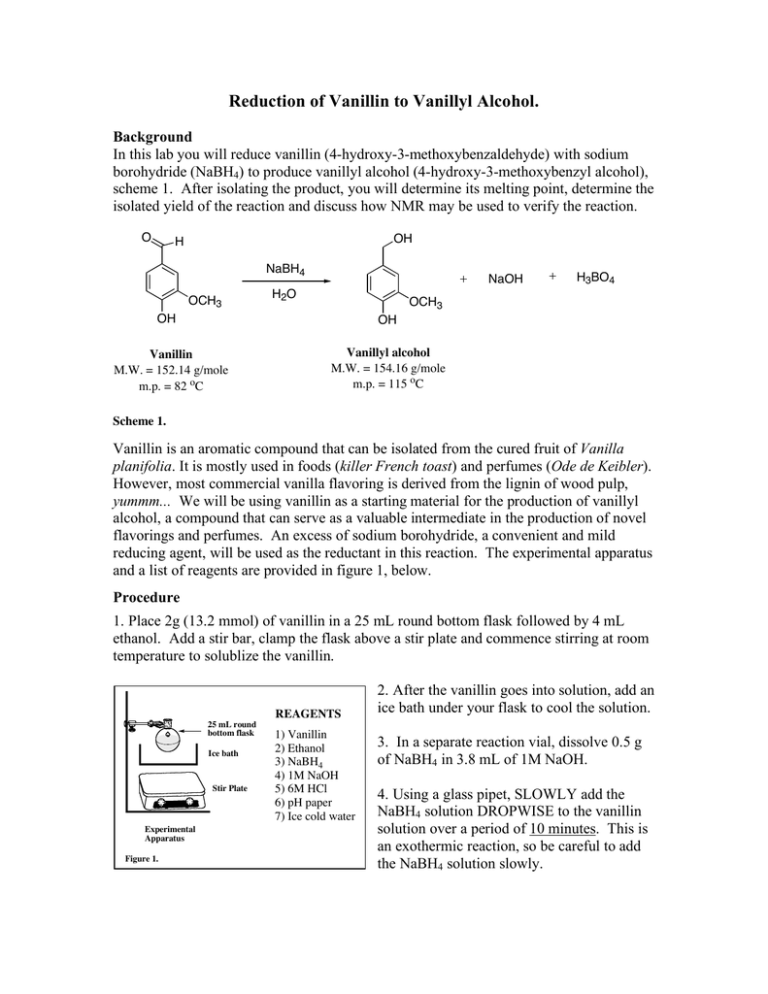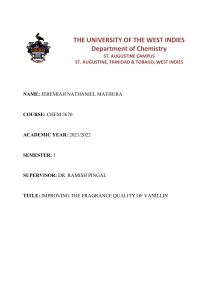Reduction of Vanillin to Vanillyl Alcohol.
advertisement

Reduction of Vanillin to Vanillyl Alcohol. Background In this lab you will reduce vanillin (4-hydroxy-3-methoxybenzaldehyde) with sodium borohydride (NaBH4) to produce vanillyl alcohol (4-hydroxy-3-methoxybenzyl alcohol), scheme 1. After isolating the product, you will determine its melting point, determine the isolated yield of the reaction and discuss how NMR may be used to verify the reaction. O OH H NaBH4 OCH3 NaOH H2O H3BO4 OCH3 OH OH Vanillin M.W. = 152.14 g/mole m.p. = 82 oC Vanillyl alcohol M.W. = 154.16 g/mole m.p. = 115 oC Scheme 1. Vanillin is an aromatic compound that can be isolated from the cured fruit of Vanilla planifolia. It is mostly used in foods (killer French toast) and perfumes (Ode de Keibler). However, most commercial vanilla flavoring is derived from the lignin of wood pulp, yummm... We will be using vanillin as a starting material for the production of vanillyl alcohol, a compound that can serve as a valuable intermediate in the production of novel flavorings and perfumes. An excess of sodium borohydride, a convenient and mild reducing agent, will be used as the reductant in this reaction. The experimental apparatus and a list of reagents are provided in figure 1, below. Procedure 1. Place 2g (13.2 mmol) of vanillin in a 25 mL round bottom flask followed by 4 mL ethanol. Add a stir bar, clamp the flask above a stir plate and commence stirring at room temperature to solublize the vanillin. REAGENTS 25 mL round bottom flask Ice bath Stir Plate Experimental Apparatus Figure 1. 1) Vanillin 2) Ethanol 3) NaBH4 4) 1M NaOH 5) 6M HCl 6) pH paper 7) Ice cold water 2. After the vanillin goes into solution, add an ice bath under your flask to cool the solution. 3. In a separate reaction vial, dissolve 0.5 g of NaBH4 in 3.8 mL of 1M NaOH. 4. Using a glass pipet, SLOWLY add the NaBH4 solution DROPWISE to the vanillin solution over a period of 10 minutes. This is an exothermic reaction, so be careful to add the NaBH4 solution slowly. 5. After the addition is complete, remove the ice bath and stir the resulting mixture for 10 minutes at room temperature. 6. Replace the ice bath to again cool the mixture. While stirring with the stir bar, add 6M HCl DROPWISE until the evolution of H2 gas stops (you are decomposing the excess NaBH4). Check the pH by removing a drop of the solution and adding it to a strip of pH paper to make sure the reaction is acidic (do not dip the pH paper into the reaction). 7. Stir for an addition 10 minutes while cooling to allow the product to precipitate from solution. 8. Collect the product by filtration using ice-cold water to aid the transfer of the material to the filter funnel. Wash the product twice with ice-cold water and then transfer the product to a dry piece of filter paper to air dry. 9. After your product has dried, weigh it to calculate the isolated yield and collect a melting point. 10. Give your product to the TA for collection. Pre-lab questions 1. Calculate the molarity of the NaBH4 solution that you prepared in step 3 above. 2. How many equivalents of hydride (H-) are you adding to vanillin in this reaction? 3. Please draw a reasonable mechanism for this reaction. 4. What is the pKa of the phenolic functional group of vanillin. Predict the protonation state (e.g. is it protonated or deprotonated) of this functional group during the course of this experiment e.g. when 1. vanillin is first dissolved in ethanol. 2. After the addition of the NaBH4 solution. 3. During the decomposition of excess NaBH4. 4. After isolation by filtration. Post lab questions 1. How could you modify your procedure to increase your isolated yield. 2. How did your melting point compare to the reported value? If lower, what can you do to increase the m.p. O H Ha Hc Hb OCH3 OH Vanillin 3. Draw the NMR chemical shift splitting pattern (tree diagram) for Ha, Hb and Hc, labeling the appropriate coupling constants. Assume Jbc = 1 Hz 4. If you had to use 1HNMR to verify that you actually synthesized vanillyl alcohol from vanillin, describe at least two key differences in the 1HNMR spectra of these two compounds that would support your claim.











